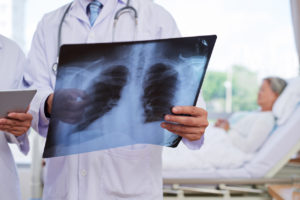Thoracic Injuries

You might remember the word “thorax” from biology in school. This was the part of the body between the head and the abdomen.
Most people do not refer to their chest as their thorax, but doctors do. And thoracic injuries can present life-threatening problems for accident victims.
Here are some facts about thoracic injuries and the compensation you can seek for them.
Table of Contents
What is the Structure of the Thoracic Cavity?

The thoracic cavity sits inside your thorax. In humans, the thorax roughly corresponds to your chest. It spans your body from your shoulders to your diaphragm.
Your ribcage protects your thoracic cavity. These 12 pairs of bones connect to the thoracic vertebrae. Ligaments hold the ribs to your spine.
The true ribs include the top seven ribs on each side. These ribs connect to the spine in your back and sternum, or breastbone, in the front of your body. Cartilage holds these seven ribs to your sternum.
The next three pairs of ribs make up the false ribs. These ribs connect to the spine but do not connect to the sternum. Instead, they connect to the true ribs through cartilage.
Doctors refer to the bottom two ribs on each side as floating ribs. They connect to the spine but do not connect to anything else. Instead, they just curve around your side and end.
Intracostal muscles sit between the ribs. These muscles help your chest expand and contract as you breathe. They also help the ribs protect the thoracic cavity.
Your Vital Organs Sit Inside the Thoracic Cavity
Your heart and lungs sit inside the thoracic cavity. The lungs connect to the trachea, which, in turn, runs to your nose and mouth.
When you inhale, your chest expands and creates a low-pressure pocket in your thoracic cavity. The low-pressure pocket causes your lungs to expand. Air rushes into your nose and mouth and down your trachea to fill your lungs.
Every cell in your body needs oxygen for cell metabolism. Without oxygen, your cells cannot burn fuel to generate energy and synthesize proteins. The oxygen in the air that you inhale gets transferred to oxygen-deprived blood. This oxygenated blood journeys from the lungs to the heart through the pulmonary veins. The heart pumps this oxygen-rich blood to your body through arteries to deliver oxygen to your cells.
All over your body, cells exchange oxygen for carbon dioxide, a waste product created by the cells. Next, the blood transports the carbon dioxide back to the heart through the veins. The heart pumps the oxygen-depleted blood to the lungs through the pulmonary artery.
The blood releases the carbon dioxide and picks up inhaled oxygen. Your lungs get squeezed by the muscles in your thorax to exhale the carbon dioxide dropped off by the blood.
How Do Thoracic Injuries Happen?
Most thoracic injuries happen in three ways:
Blunt Force Injuries
Blunt force injuries happen when a force hits your chest without penetrating the thoracic cavity. These forces can tear blood vessels and cause internal bleeding.
You do not necessarily need to suffer chest trauma to have a blunt force chest injury. Rapid acceleration or deceleration like that experienced in a fall or car accident can tear the tissue in your thoracic cavity.
Penetrating Injuries
Penetrating injuries occur when an object pierces your chest wall. The penetrating object can damage your lungs, heart, or major blood vessels inside your thoracic cavity. It can also create a leak in your chest wall that causes your lung to collapse.
Blast Injuries
Explosions create a pressure wave. When this pressure wave hits you, it squeezes your lungs. If your lungs have air in them, the pressure wave can cause an injury called blast lung. The tiny air cells in your lungs can rupture when squeezed by the blast wave.
This injury happens in combat soldiers. It can also happen in workplace accidents in industries like mining, oil and gas extraction, and demolition.
What Are Some Examples of Thoracic Injuries?
Thoracic injuries can take a lot of different forms, including:
Fractured Rib
A force can fracture a rib. In most cases, fractured ribs are painful but not life-threatening. A fractured rib will heal in about eight weeks without surgery or even taping or wrapping the chest.
But in rare cases, a fractured rib can lead to more serious injuries. The broken end of the rib can pierce the chest wall, damaging the pleural lining or lungs.
Pneumothorax
Pneumothorax happens when air enters the chest between the lungs and pleural lining. Normally, the pleural space forms an airtight vacuum so the lung can expand. When air gets into the pleural space, the lung cannot expand and take in air. As more air leaks into this space, the lung may collapse.
Without emergency treatment, you could die from a pneumothorax. Doctors treat a pneumothorax by sucking the air out of the pleural space. This allows the lung to re-expand.
Hemothorax
Hemothorax is similar to a pneumothorax. But instead of air, blood leaks in the pleural space. Again, the lung cannot push out the blood, so the lung cannot take in any air. You will struggle to breathe until doctors suck out the blood.
Cardiac Tamponade
The heart sits inside a protective sac called the pericardium. This sac protects the heart from infection and prevents it from rubbing against other organs when it beats.
Cardiac tamponade occurs when the pericardium fills with fluid. The fluid strangles the heart and can cause arrhythmia or even cardiac arrest.
How Do You Get Compensation for Thoracic Injuries?
You can seek compensation for thoracic injuries caused by someone else’s negligence. However, you must prove that your thoracic injury happened because someone failed to exercise reasonable care, causing your injury.
For example, in a pedestrian accident, you can seek compensation if you got hit when the other driver failed to look at the crosswalk before turning right.
Thoracic injuries can threaten your life. They may require expensive and painful chest surgery. They may also require a long recovery time. As a result, you may incur substantial damages after a thoracic injury. Contact the Stephens Law Firm, PLLC to schedule a free consultation to discuss the compensation you can seek for your thoracic injury.
Stephens Law Personal Injury | Wrongful Death | Truck Accidents
1300 S University Dr # 300
Fort Worth, TX 76107
(817) 420-7000


